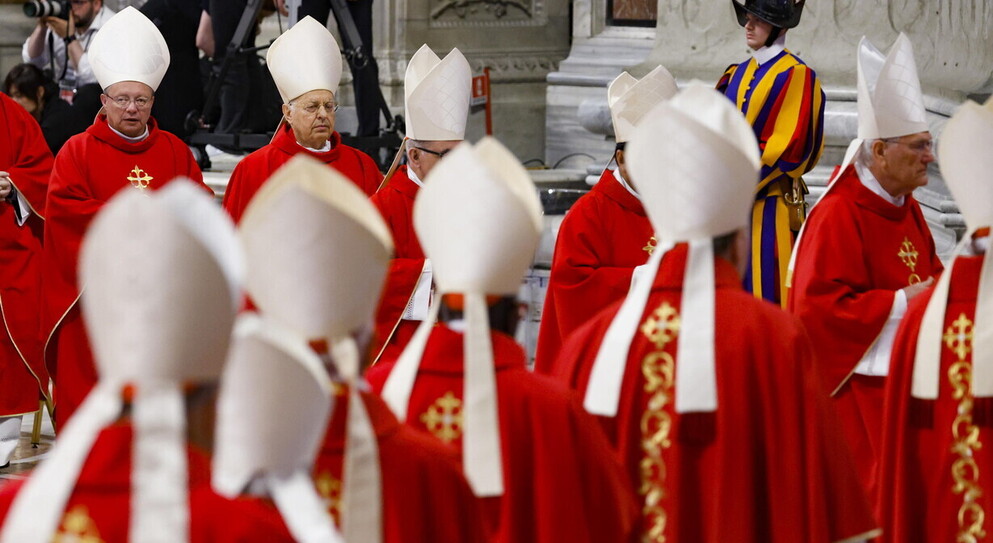After discussions on peace and migrants, the cardinals are reminded that a synodal process is underway—intended, at least in theory, to last longer than Vatican II. What influence will it have in the Sistine Chapel?
This article was originally written in italian and can be read here. The english version is translated by artificial intelligence.
After days of debating the fate of Giovanni Angelo Becciu, with cardinals from the so-called peripheries growing increasingly impatient—“How long will this go on?” one of them asked a seasoned curial cardinal seated nearby—the speeches began to heat up. With the usual rhetoric about the poor, the marginalized, the environment, and global peace pushed somewhat to the side, it became time to try to outline the profile of the man who will inherit Pope Francis’s complex legacy. Predictably, as the moment to enter the Sistine Chapel draws near, the topic of synodality has come to the forefront. This theme is dear to the cardinals farthest from Rome and somewhat less so—barring some significant exceptions—to the curial Romans.
Cardinal Jean-Paul Vesco casually noted that two synodal assemblies had taken place in the past two years, during which all participants had been treated equally, “around tables.” Other cardinals emphasized how meaningful those experiences had been for them—experiences that, they argued, should not be excluded or marginalized in discussions about the next Pontiff. The topic came up extensively yesterday during the seventh congregation. In fact, the Synod on Synodality has not yet concluded, as the most delicate and controversial issues—those that could lead to splits and dramatic counts—were set aside by Pope Francis for further exploration in specific commissions, which are expected to release their findings soon. Diaconate, celibacy, laity, and so on: the usual recurring themes. Reconciling Africa with Europe is complicated—Francis knew this better than anyone—especially after the fierce opposition to the declaration Fiducia supplicans, penned by his trusted prefect of the Dicastery for the Doctrine of the Faith, Víctor Manuel Fernández.
Some members of the College want to press forward, even at the cost of internal rifts. This was made clear by Cardinal Michael Czerny, a Jesuit, who stated that unity should not become a mantra. If it’s present, great. If not, courage is needed. Another Jesuit, Cardinal Jean-Claude Hollerich—an astute thinker known for his clear and pedagogical style—agrees. He was one of the mediators sent by Pope Francis to Germany to seek compromise with the Germans, who were outraged by the Roman vetoes on their Synodaler Weg. The other night, while the novendiali (nine-day funeral rites) were being celebrated in St. Peter’s Basilica with Archpriest Gambetti, Hollerich was elsewhere, at another well-attended Mass happening simultaneously. It wasn’t a papal candidacy—these things aren’t done—but it did signal a distancing from the vague rhetoric that skirts around the core issue without fully addressing it: What should be done tomorrow? What kind of Church should be presented?
This is why the issue of synodality cannot be buried with Francis—quite the opposite. The Latin American cardinals—often simplistically labeled the most progressive—certainly haven’t shelved the aspirations that emerged during the Amazon Synod: a pastoral reform of the Church’s presence in mission territories and areas where evangelization is more complex. Analysts are now focusing on them—eighteen South Americans and six Central Americans—wondering: how will they act? Will they seek a compromise or insist on their core demands?
According to one line of thought, it’s hard to imagine this portion of the College suddenly and unequivocally supporting curial profiles with no experience leading a diocese—or even a parish. Of course, it could happen, but only as a fallback if the Conclave proves more difficult and fragmented than it currently appears. (Matzuzzi continues on page four.)
Others, however, believe that carrying out more complex agendas requires precisely the experience of a moderator. In 2013, the pre-conclave congregations were also dominated by discussions about the next pope’s program, as Francis has often recalled. That’s where the idea of the C9—the “Council of the Crown”—was born, to reform the curia and advise the pope on governing the universal Church. Will something similar happen this time?
The reform of the curia—a process that took nearly a decade—produced the Praedicate Evangelium constitution, a document full of (even substantial) errors that ultimately created more confusion than originally existed. So, was the C9 a fortunate idea? Will any cardinal propose something similar? Or, more likely, will there be calls to restore order before embarking on new innovations?
The emerging fallback option, whispered perhaps to test the waters (in the media and among disoriented cardinals—and there are quite a few), could be Mario Grech. The General Secretary of the Synod. Praised for how he managed the proceedings (though in such cases, only the praisers speak—others prefer to stay silent), he has all the qualities that might make someone in the Sistine Chapel give him serious consideration: 68 years old, European but from the periphery (he’s Maltese), a Mediterranean islander, a bridge between Europe and Africa, a curial figure with diocesan experience, faithful to Francis’s line but with measured Western caution. The conservative wing doesn’t like him, but if the front-runners turn out to be weaker than they seem, the “synodal” majority might rally around a cardinal who, all things considered, doesn’t cause too much trouble.

